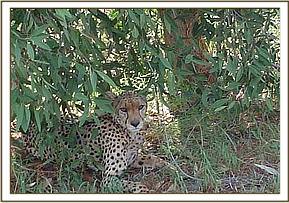Five cases were attended to this month, four of which were elephants
Five cases were attended to this month, four of which were elephants. Of the cases reported to the unit only one, a giraffe with a snare near Buchuma gate was not found. The failure to locate it was attributed to a delay in relaying the report to us which arrived two days after it was sighted. A detailed report of the cases attended to is described below.
Elephant with snare wound at Sala Gate This was the first case in the month of February. It was reported by the rangers stationed at Sala Gate on 6th February. It was a bull in a herd of seven other bulls. From a distance, we could see a wound and swelling round the lower part of the left hind leg obviously inflicted by a wire snare but we could not tell whether the snare was still there or not. The injury was however not interfering with movement and posture. We decided to immobilise the elephant for a detailed examination of the wound and treatment. Immobilisation was achieved by 19mg M99® but the animal went down in a rocky area. The rocks were pressing onto the abdomen and chest leading to compromised respiration. This required us to act very fast before the animal succumbed to respiratory insufficiency. Examination of the wound did not reveal any foreign object, and the snare must have come out after a prolonged period judging by the extent of the injury and swelling. The wound was cleaned and treated topically. The animal was also given an antibiotic cover of long acting oxytetracycline before it was revived with 60mg M5050®.
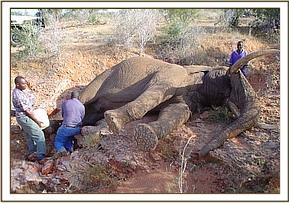


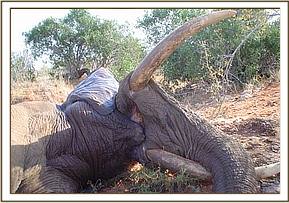

Elephant calf with winch cable snare on the trunk near Satao Camp. The calf was about 5-6 years old in a family group of about eight. The resulting wound was deep, the created gap was wide and the nostrils were exposed. The calf however looked healthy and it was observed for sometime effectively using the trunk to browse. A big portion was still remaining holding the trunk in position. The only problem would be drinking water as it would come out through the exposed nostrils. It can only manage by dipping its mouth into the water. After we immobilised the calf, the other family members became aggressively protective and refused to go away to enable us reach it. One of the elephants which we thought was the matriarch or the mother hit the vehicle in the process. It took us about 15 minutes to drive them away to within safe distance. The snare was subsequently removed, the wound treated topically, and a systemic long acting antibiotic administered.

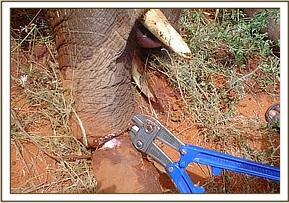



Giraffe with winch cable snare near Satao Camp The snare was hanging loosely round the neck; no wound had been inflicted. It was immobilised with 12mg M99® and 20mg Xylazine Hcl. Its flight distance was long occasioning lose of two darts. The third dart landed on the shoulder but the animal became only slightly sedated due to incomplete discharge of the dart. It was given a fourth dart of the same amount after about 20 minutes which made it sufficiently sedated to be roped down. The head was held down and M5050® and Antisedan® were administered immediately it went down to antagonise the two drugs respectively. Long acting oxytetracycline was administered and the snare was removed. The whole process was done very fast and was complete in less than 10 minutes. The animal was then given time to stand on its own.
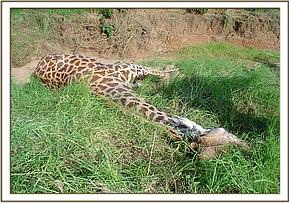

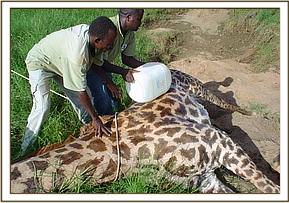

Elephant calf with winch cable snare in Amboseli The calf was aged about two years in a large family of 13. The snare was deeply embedded and required radical surgery to reach and remove it. It was a long standing case judging by the extent of the swelling and the fact that healing had taken place over the snare and only a small portion was exposed at the back. Topical and systemic long acting antibiotics were also administered. The calf was revived and rejoined with its group.
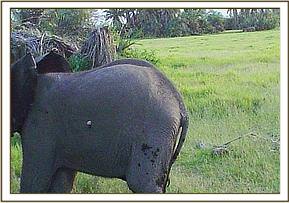
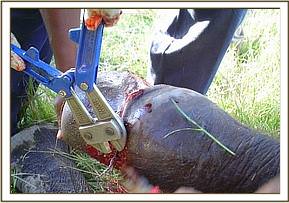
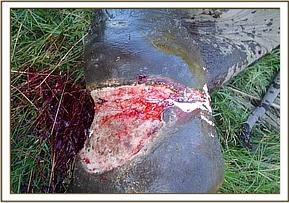

Assessment of Tullip Tulip is the tusk-less female with a penetrating spear wound at the base of the trunk treated in Amboseli in January 2004. Concern had been raised whether the wound had healed because the elephant had been seen occasionally dusting its trunk. From a distance, the wound looked healed with no infection or swelling at the point of injury. However we thought it prudent to immobilise the animal and rule out all doubts. This was done and our observations were confirmed.
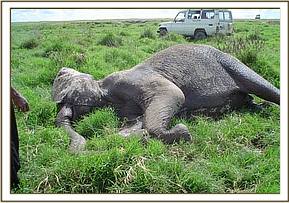
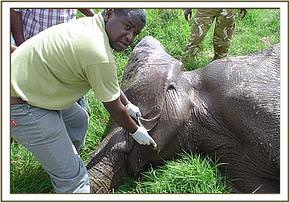

Wounded Cheetah The cheetah was treated on 10th January and had last been seen on the 13th January. It had a big laceration on its left hip area which was sutured with chromic cat gut. It also had a superficial wound at the abdominal area that involved the top layer of the skin only. The laceration had apposed nicely when it was sighted last. It was again seen on the 22nd February weak and hungry and we decided to provide it with some meat. The wound was observed to have healed and only a small portion of the laceration probably resulting from suture dehiscence was remaining to appose completely.

